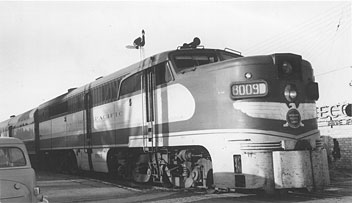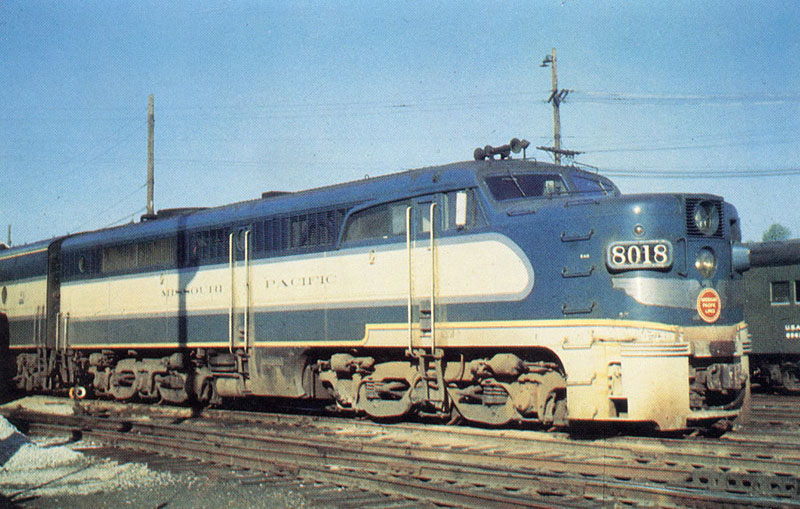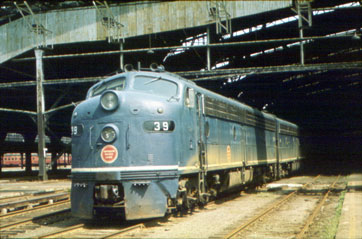|
||||||
| HOME Power Cabooses Rolling Stock MoW Depots | ||||||
|
Steam
|
Switchers
/ Slugs
|
Streamliners
|
1st
Gen Diesel
|
2nd
Gen Diesel
|
Prime
Power
|
Merger
Era
|
Post
Merger Era
|
 |
 |
 |
 |
 |
 |
 |
 |
| 1800s-1930s | 1930s-80s | 1940s | 1950s | 1960s | 1970s | 1980s | Today |
| All | All | All |
GP35 & 28 GP38 GP38-2 U Boats |
SD40 SD40-2 SD40-2c B Boats GP15 & 50 |
All |
![]()
Streamlined for Success - the 1940's-'50's
Click on the thumbnails to see a larger image
| the E-3, AA6, E-6 and FT |
|
1939 marked the introduction of the first streamliners on the MP system. These included EMC/EMD-built E3, AA6, and E6 diesels, each painted in an all-new elaborate blue/gray design with yellow trim and a MPL stainless steel spread-eagle on the nose. These were part of the new "Route of the Eagles" passenger service, which in the foloowing years spread as far west as the Grand Canyon and California. The Missouri River Eagle was inaugurated March 10, 1940 for the St. Louis-Kansas City-Omaha passenger service. Two EMD E-3's, #7000 and 7001 were the units on the River Eagle's first run. 1940 was wartime - the streamlined EMD FT was delivered to MoPac in a slightly less elaborate paint scheme from her passenger-assigned sisters, and invaded the steam ranks as it went into freight service to help the war effort. |
|
|
 |
MP E-3 #7001 - at Jefferson City, Missouri on June 6, 1948. The sleek E-3 is seen here with the Colorado Eagle, a later run that was an outgrowth from its original assignment to Missouri River Eagle some eight years earlier. Notice the dome of the Missouri capitol building in the background. - Arthur B. Johnson Photo, T. Greuter Collection |
| the PA-1, PA-2 AND PA-3 |
|
1947-51 saw the deliveries of the the Alco/GE PA-1, PA-2 and PA-3 (its been argued that the PA-3's were in fact modified PA-2's). |
 |
|
 |
MP 8009 - an ALCo PA-2 at Raymondville, Texas on August 7, 1952. Built on 5/50, the #8009 would later be renumbered as MP 52 before being retired in 1964-65 to Chaneysson Electric. - Arthur B. Johnson Photo, T. Greuter Collection |
 |
MP 8018 - an Alco PA unit at Kansas City, Missouri in June 1961 - postcard, T. Greuter collection · |
 |
MP 8019 - A PA-3 at Texarkana, Texas on March 4, 1956. The #8019, built 5/52, will go on to be renumbered as MP 62, retiring in 5/64 to Chandeysson Electric. - Arthur B. Johnson Photo/T. Greuter Collection |
|
Diesel Details |
|
Diesel Details |
| the FA AND FB |
| The Alco FA & FB were especially prevalent on the Omaha division. MoPac found their rapid acceleration and speed capabilities were right at home on the rail-center's endless up-and-down hill grades. |
| By the close of World War II, MoPac had purchased 734 diesels and 115 B-units. |
| the DR-4-4-1500 |
|
The DR-4-4-1500's a.k.a. 'Babyfaces' along with the DRS-4-4-1500's all came with pneumatic MU control, which prooved to be a slight problem, as EMD & ALCo did not use this method, making it impossible for the different units to MU together. Due to this situation, all the AS-16s had the preferred "EMD" standard MU controls installed in later years. These tempermental machines were restricted to the Arkansas division in the mid-1950's, replacing the last steam engines on the MoPac. They were prone to breaking-down and were universally disliked by crews and the mechanical department alike. |
| the E7-A AND E8 |
|
1947-51 also saw the deliveries of the EMD E7 and E8. |
 |
MP 14 - E7A on passenger at St. Louis, Missouri Union Station in March, 1964. - photo © 1964, 1995 by Jerry Appleman-Jerry's Railroad PhotoAlbum. |
 |
C&EI 27 - E7A on train #4, The Danville Flier at Danville, Illinois in May 11, 1969. - photo © 1969, 2000 by Jerry Appleman. |
 |
MP 39 - an E8A, pokes a nose out of the train shed (in St. Louis?), the units have a good bow-wave coating of dust. Jerry Carson, the photographer, took most of these 60's-70's shots in the St Louis - Dupo area. - Jerry Carson Photo/T. Greuter Collection · |
 |
C&EI E-unit #1941 - Photographer unknown / Jay Glenewinkel purchased photo collection. |
 |
T&P 2005 - St. Louis, December 1961 - Gary Morris Photo or Collection |
| the BL2 |
|
Built in April 1948 and September 1948, MoPac purchased eight BL2's, #4104-4111. All were retired in 1962 and traded in for GP18's #534-549. These units never wore Jenks blue. The BL2 was EMD's first attempt at the still new diesel roadswitcher concept, it's hybrid appearance (it was a precursor to the yet- to-come GP7) of a covered wagon with a nose walkway could be considered as something of a "streamlined roadswitcher." |
| the F3, F5, F7-A, F8, FA-1, FA-2 AND FPA-2 |
|
MP 801 - F7A in an ABBA arrangement. The units are in the Jenk's Blue paint scheme. From an EMD builder's card produced to compare and promote diesel power. - EMD Photo |
 |
MP F7 #591 - was built in October 1949 (all F7s originally numbered from 577-626). It was later renumbered to MP 810 as part of the 1962 renumbering system. The unit was retired in March 1970, and traded in to EMD for the new SD40s. - Photographer and Location unknown /Jay Glenewinkel Purchased Photo Collection |
 |
I-GN 604 - a 2-unit EMD F7A freight at San Antonio, Texas on September 2, 1952. The 604 was built on 9/49 and would later be renumbered as MP 823 before being retired in 1971 as a trade-in to EMD. Also, just for interest, the #604 photo is an extremely "rare" example of an F7 that is shown with the anticlimber painted blue. Mopac F3s and F7s normally had the anticlimber painted Eagle Gray (prior to the 1961 Jenks blue scheme, of course). (thanks to Ed Hawkins) - Arthur B. Johnson Photo/ T. Greuter Collection |
 |
T&P F7 #864 - was built in November 1949 as Texas & Pacific #1514. It was later renumbered to T&P #864. It was renumbered again to its final number as T&P #1864. It was retired in 1974 and traded in on the SD40-2 purchase for the C&EI. - Photographer and Location unknown/Jay Glenewinkel Collection |
|
In 1947-51, large numbers of the EMD F3, F5, F7 and BL2, and the Alco/GE FA-1, FA-2, and FPA-2 being built for MP subsidiaries Texas & Pacific, International Great Northern, Kansas Okalhoma & Gulf, St. Louis, Brownsville & Mexico, as well as MP. |
 |
T&P 884 - an EMD-built F7A is the lead unit seen at a small depot in the laters years of it's employment in the early 1970's. Now coated in unglamorous Jenks Blue, and with the take-over of passenger service by Amtrak, she's saddled with the task of hauling mixed freight. It'll retire in August 1973. The only distinction the 1950-built unit has from it's MP sisters is a small subletting beside the buzzsaw decal. Grapeland, Texas, 7/70 - © Brian Paul Ehni Photo |
|
Diesel Details |
 |
KO&G F7A 751 - and F7B at Henryetta, OK, date unknown. (shows 'as delivered' herald with Midland Valley on top) - photographer unknown, Robert F. Read Collection / submitted by Gary Herron |
 |
KO&G F7B 755B - at Muskogee, OK, unknown date (original paint with revised herald with KO&G on top, which occurred after KO&G became the dominant revenue road. See Stagner's book for more info) - photographer unknown, Robert F. Read Collection / submitted by Gary Herron |
 |
MV F7 #751 - No information available (obtained from Charlie Duckworth) - photographer/date unknown /Gary Herron Collection |
| the DS-4-4-1000 AND DRS-4-4-1500 |
|
February 1948 - the Baldwin DS-4-4-1000 and DRS-4-4-1500 were built for MP. |
| the E8 |
 |
|
 |
MP 31 - a lone E8A huffs and puffs with a three-car consist of baggage, standard passenger and observation cars, apparently somewhere in the wooded hills of the Missouri River valley of Nebraska. - photo © William W. Kratville/T. Greuter Collection |
 |
T&P 32 - an E8A powered light at Denver, Colorado's Union Station in August, 1965. - photo © 1965, 1998 by Jerry Appleman. |
| In Nebraska, from the Eaglette streamlined motorailer in the 50's to the final bus connection for Lincoln's passenger service in 1963, the Missouri River Eagle continued to stop at Union on it's St. Louis-Kansas City-Omaha run until September 1965 - E8A T&P-36 made the final run. |
 |
|
 |
|
 |
|
 |
MP 40 - an E8A powered light at Kansas City, Missouri in August, 1965. - photo © 1965, 1998 by Jerry Appleman. |
 |
MP 41 - E8A on train #16, the Missouri River Eagle at Warrensburg, Missouri, February 14, 1970. - photo © 1970, 2001 by Jerry Appleman. |
 |
MP 41 - with a passenger train trudges through the snowswept Warrensburg; 1970's - Mike Cafferata Photo |
 |
MP 41 - traveling on a warmer day; 1970's - Mike Cafferata Photo |
 |
C&EI 43 - at Warrensburg station. Note the Fairmont Speeder on the MoW truck; 1970's - Mike Cafferata Photo |
 |
C&EI 43 - the run of the Last Texas Eagle; 4/30/71 - Mike Cafferata Photo |
|
By the early 1970's, passenger service disappeared across the nation to be taken-over by Amtrak. MoPac's aging F7's, F8's and their B-units found a new if less glamorous life as they began filling-out freight-hauling rosters in their final days. |
![]()

|
Featured
Photographers: Sources:
Recommended
Links: Every effort has been made to get the correct information on these pages, but mistakes do happen. Reporting of any inaccuracies would be appreciated. |
|
trainweb.org/screamingeagle l Last Update
to this page: 18 April, 2008
|
|
| All images & text © 2000-2008 T. Greuter / Screaming Eagles, unless otherwise noted. All Rights Reserved. | |